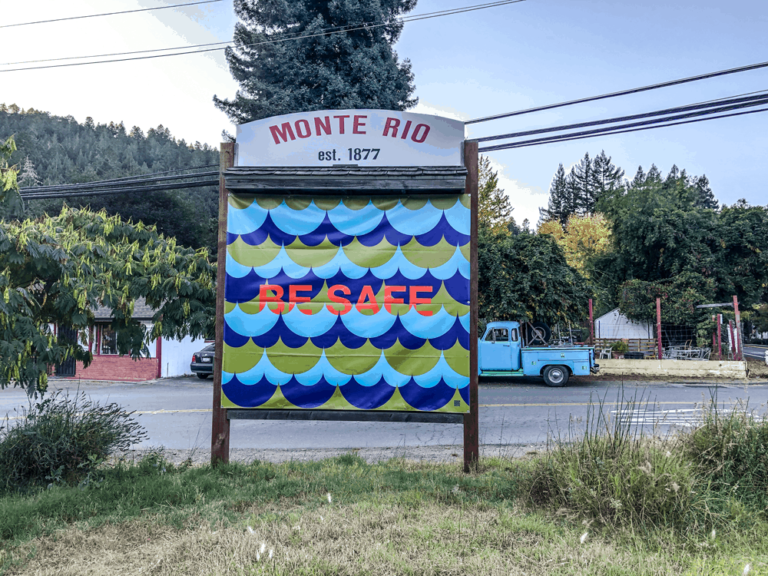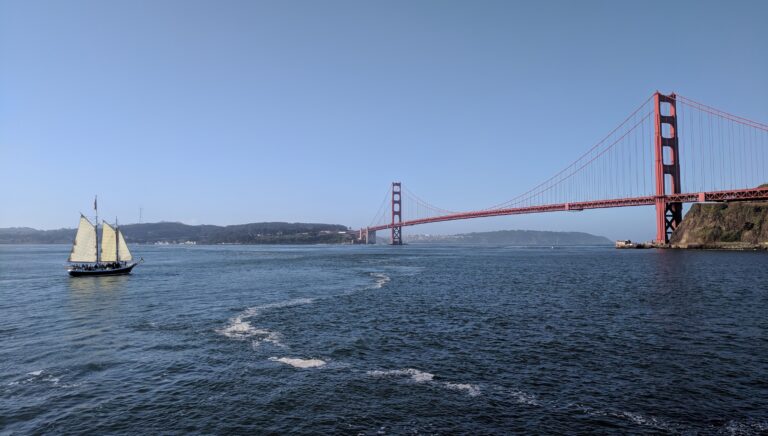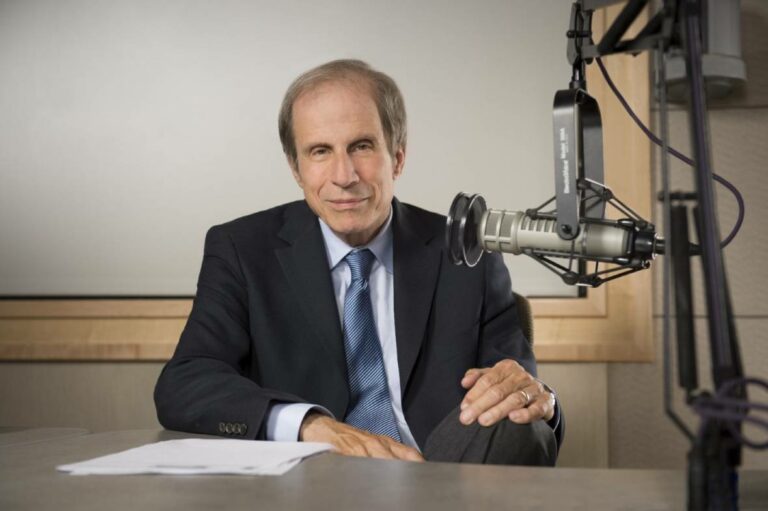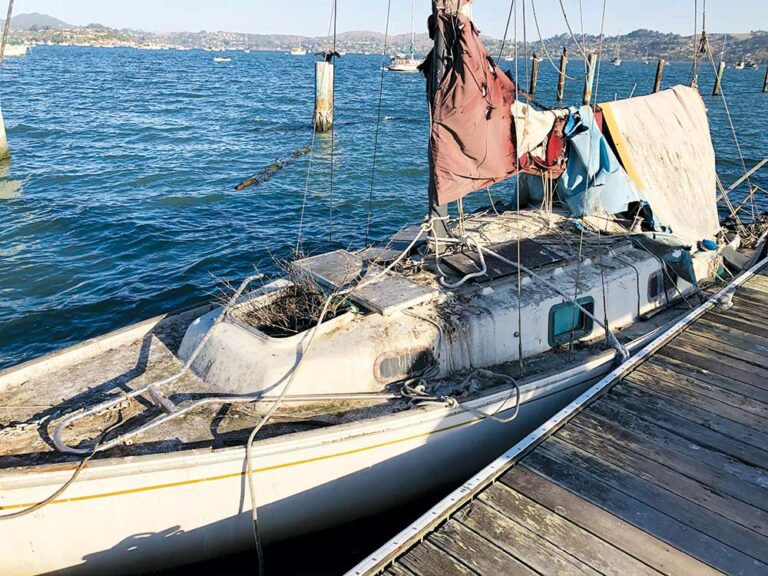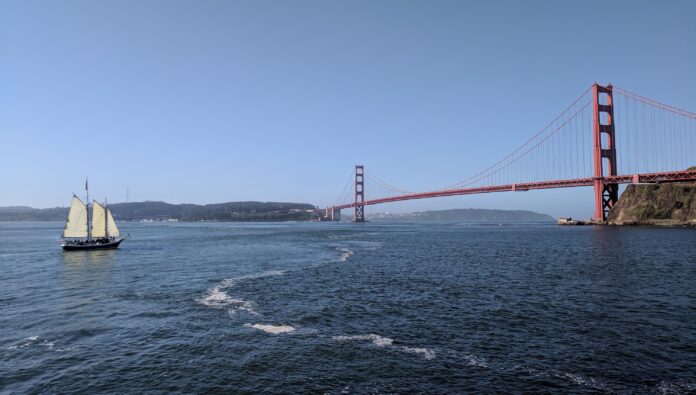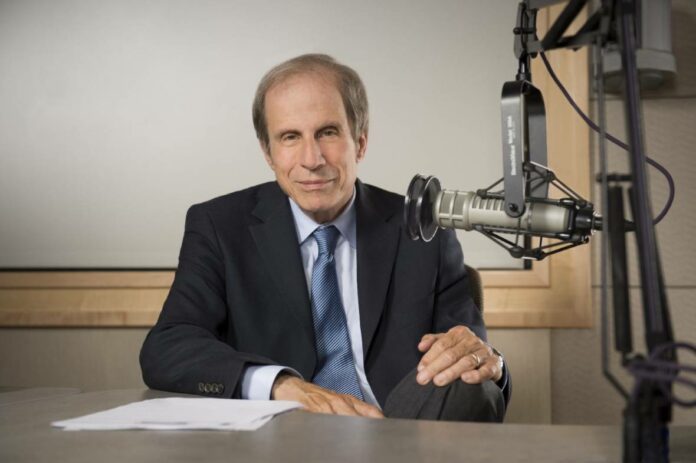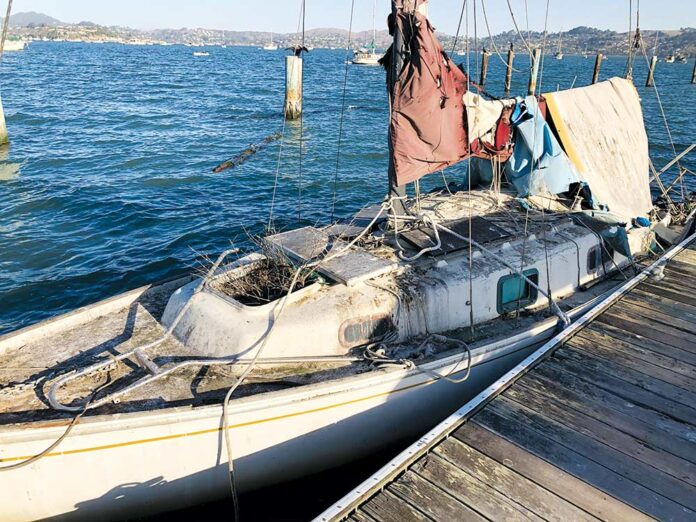No rent, no mortgage, no property taxes. The allure of living for free in Marin has attracted many people over the years to take up residence on boats anchored in the open waters of Richardson Bay.
Currently, 135 vessels remain anchored off the shorelines of Sausalito, Mill Valley, Tiburon and Belvedere, according to a recent count by local officials. The people who live on those boats are often called “anchor-outs.”
Much to the chagrin of the authorities governing the waters, most anchor-outs refuse to give up their floating dwellings, although applicable laws state that vessels in Richardson Bay may idle only for 72 hours, unless granted permission to stay longer. Inconsistent enforcement of the law has allowed more and more boats to come into the Bay, drop anchor and set up makeshift homes.
Now, despite the on-going pandemic, a state agency is pressuring local officials to remove the anchor-outs from Richardson Bay.
The San Francisco Bay Conservation and Development Commission (BCDC), a state agency, was established in 1965 to regulate development in and around the San Francisco Bay. The Richardson Bay estuary falls under its purview.
But the BCDC has not consistently required Sausalito, Mill Valley, Tiburon, Belvedere and Marin County to enforce the 72-hour anchorage regulation.
“Until the Fall of 2015, the BCDC did not have an enforcement attorney,” said Larry Goldzband, BCDC Executive Director. “Before that, the BCDC had two people doing enforcement. We hired chief counsel in 2015, and then when we were able to hire enforcement counsel and an enforcement manager, we began growing the enforcement program.”
Apparently, the program did not grow quickly enough for the state, because in May 2019, the state auditor released a report concluding the BCDC’s “failure to perform key responsibilities has allowed ongoing harm to the San Francisco Bay.” The report refers to, among other issues, a case opened in 2010 involving 200 vessels anchored illegally in Richardson Bay.
“Commission staff have indicated that many of these boats are in a state of disrepair and that they frequently sink, resulting in the release of harmful chemicals into the Bay,” the report states. “Although the illegally moored boats in Richardson Bay have harmed a delicate ecosystem, the commission has done little to resolve the situation.”
After the auditor’s report was issued, the BCDC began pressuring Richardson Bay authorities to step up enforcement of the 72-hour law. The authorities include the City of Sausalito and the Richardson’s Bay Regional Agency (RBRA), a coalition of the governments of Belvedere, Mill Valley, Tiburon and unincorporated Marin.
The enforcement efforts were paused during the early months of Covid-19. But, in a recent virtual meeting, BCDC officials urged local officials to clear Richardson Bay.
“The Richardson Bay problem needs to be fixed,” Goldzband said. “We explained to the RBRA and Sausalito that it’s their responsibility to enforce the law.”
Sausalito, it appears, has made great strides. Once a member of the RBRA, Sausalito cut ties with the agency in 2017, because the city was one of the largest financial contributors, yet was not given a role in setting policy.
“When we left the RBRA, we had 90 boats in Sausalito waters,” said Sausalito City Councilmember Joan Cox. “Today we have six occupied and three unoccupied boats.”
The six occupied boats are “legacy” anchor-outs and “older folks” live on them, Cox said. The city asked the BCDC to defer enforcement of removing these boats, as the occupants are experienced mariners. Cox anticipates it could take five years to reduce the number of legacy vessels. Sausalito law enforcement is working with the Ritter Center, a Marin nonprofit that helps prevent homelessness, to find marina housing for those in need.
The RBRA is also working to reduce its number of anchor-outs; however, it has not been as successful as Sausalito, likely because it has only one staff member. Curtis Havel, the RBRA harbormaster, began working for the agency in July 2019, just after the BCDC began cracking down on the RBRA to rid Richardson Bay of the anchor-outs.
Currently, 126 boats remain in the Richardson Bay waters that Havel patrols—120 occupied and six abandoned.
Havel’s rule is that at least two people must be on his boat to approach anchor-outs, as his life has been threatened more than once. Fortunately, he works in cooperation with the Marin County Sheriff’s marine patrol unit and the Coast Guard.
The RBRA has had more than 80 unoccupied, unseaworthy boats seized and destroyed since August 2019, though the practice was halted during Covid-19, according to Havel.
Robbie Powelson, Tam Equity Campaign founder, alleges the RBRA has a disturbing trend in home destruction.
“Literally, everyone I have confirmed as having lost a home to Curtis Havel has been a woman,” Powelson said in a written statement. “I have met men losing boats under extraneous circumstances, but only women have reported to me losing their homes while they were still living in them.”
Although the Pacific Sun reached out to several of the women named by Powelson, none returned calls for comment.
“There’s a narrative associated with the anchorage that I’m seizing boats and making people homeless during the pandemic,” Havel said. “That’s simply not true. My goal isn’t to take away anyone’s home. It’s to make the anchorage a safer place. Right now, there are 17 boats out there that can save themselves and another 10 that are operational. The rest aren’t seaworthy.”
The RBRA is also working with housing outreach partners. According to Havel, a housing advocate is usually on his boat on a weekly basis. They know who occupies each boat and they have their phone numbers.
Even as Sausalito and the RBRA work to find alternative living arrangements for the anchor-outs, the BCDC is not relenting. They want Richardson Bay free of anchor-outs as soon as possible.
“People can’t live on the Bay,” Goldzband said. “That’s not what it’s for. There are no shopping centers in the Bay. There are no movie theatres in the Bay. You cannot just put a boat in the middle of it and not have [the boat] move.”
“I don’t think it’s a homeless issue,” he continued. “The people on the Bay are living illegally. If these people need a place to live, the local governments need to deal with it.”
One thing all parties agree on is that loss of life is unacceptable. Recently, a man had a heart attack after his boat crashed into another boat in the anchorage. Another resident was located in her boat and pronounced dead by San Rafael Fire Department paramedics. The Marin County Coroner’s Office has yet to determine her cause of death.
Goldzband said he has full faith the local governments will be able to ensure the safety of their residents.
Havel is not as certain. With winter storms approaching, he is concerned about the unseaworthy vessels. After all, 135 boats remain anchored out in Richardson Bay.
“People buy a boat for nearly nothing in the middle of the summer,” Cox said. “Then winter comes. People just don’t realize how treacherous it is to live out in the Bay.”
EDITOR’S NOTE: Paragraph 28 has been updated with information from the Marin County Coroner’s Office.

